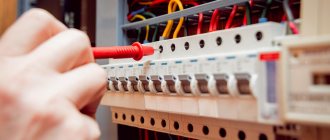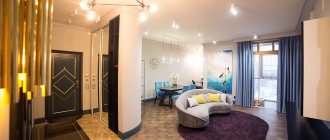Some repair or reconstruction work requires registration and registration. Before they begin, it is necessary to check that the planned activities are carried out in accordance with the law. Otherwise, there will be punishment from government agencies in the form of a fine.
In order to coordinate the redevelopment of an apartment as quickly as possible, it is recommended to contact commercial companies that have a license for such activities. This will help save not only your budget, but also your precious time.
What is considered redevelopment in an apartment that requires approval
When determining what is a redevelopment of an apartment and what is not, you should familiarize yourself with the legislative norms. Article 25 of the Housing Code stipulates that repair work related to changes in the location and configuration of premises are redevelopment. All this must be taken into account in the technical passport in accordance with all current rules, which will help to avoid subsequent controversial situations when buying and selling real estate.
To improve living conditions, some property owners and tenants carry out major renovations that involve moving the walls in the apartment. All these actions must be registered with the BTI. But many citizens do not want to fulfill such conditions, because the price for registration is about 2,500 rubles, and they will have to work on this matter for up to two months, filling out and collecting the necessary papers.
All this, as a rule, ends in considerable fines, and unauthorized redevelopment will have to be legalized in any case, because it will be impossible to sell such an apartment. Therefore, you should plan this procedure in advance, create a plan of all necessary measures and contact BTI representatives with them to coordinate the redevelopment of the premises.
Actions to change the housing configuration cannot be carried out in the following cases:
- increase the area of kitchen premises and bathrooms at the expense of the footage of living rooms (it is impossible to expand these elements of the apartment by more than 25% of the living space);
- combine kitchens with other living space using arched structures when the housing has a centralized gas supply (this is possible when apartment buildings are equipped with electric stoves);
- demolish load-bearing walls and partitions;
- dismantle or move engineering and technical communication structures (hot water and hot water pipes, radiators, ventilation ducts, openings);
- move the toilet and bathtub to areas of the apartment where residents have living rooms below (except for rooms with two tiers);
- move heating radiators or make a branch from the central system on balconies and loggias;
- increase the balcony space with the help of living space (you can combine them with arched openings that are no wider than a meter).
In addition to such prohibited measures, you should know that when overhauling, you cannot worsen the existing living conditions in apartments. In this case you can:
- combine the kitchen space (including with a gas stove) with the rest of the living space with installed doors, arched devices, sliding mechanical devices;
- increase the toilet and bathroom using corridors, but the level of flooring outside these rooms should be lower;
- move water and heating pipes from the riser, increasing their length, but leaving the same drainage angle.
Also, when carrying out reconstruction and major repairs, you should take into account the time of work (from 9.00 to 22.00 on weekdays and from 10.00 to 22.00 on holidays).
Differences in coordinating the redevelopment of apartments and apartments
Many restrictions imposed on the redevelopment of apartments do not apply to apartments that do not belong to the housing stock.
This means that the owner of the apartment has an almost unlimited opportunity to realize in the configuration of the premises all his ideas about comfortable housing for him.
- Redevelopment of apartments does not have to take into account the division of the premises into residential and non-residential areas, as in any apartment. That is, the kitchen and bathroom can be located where it is convenient for the owner.
- A studio apartment or living room-kitchen can be fully realized in the apartment, even if it is equipped with a gas stove. In an apartment, such a kitchen would be required to be separated from the living space by a partition and flooring made of a different material.
- Unlike an apartment, there is no distinction between “dry” and “wet” zones in apartments. This means that the bathroom and toilet can be one room or two different ones and located anywhere in the apartment where it is convenient for the owner.
What does not require approval
The following activities do not require registration:
- gluing various wallpaper coverings, painting ceiling and wall structures;
- installation and replacement of furniture elements, this also applies to built-in models;
- change of plumbing equipment, heating appliances, any work on balconies and loggias;
- installation of air conditioners and antenna masts from the street;
- rearrangement of kitchen stoves and their replacement;
- installation of door structures and partitions that will not put pressure on the overlapping elements;
- demolition of non-load-bearing wall structures and vestibules;
- equipment of openings in non-load-bearing wall structures.
All this can be done without permission. Confirmation for repair work is required when making major changes: moving or demolishing the load-bearing structures of the house. Then it is necessary to prepare a project and obtain permission for construction work. Coordination of the redevelopment of load-bearing walls is required. During illegal redevelopments that have not received approval from specialists, the load on the load-bearing walls may be disrupted, which is fraught with the appearance of cracks in them, and sometimes the collapse of multi-story buildings.
Redevelopment of an apartment - what is possible and what is not?
Current legislation allows you to familiarize yourself with the rules of redevelopment and its features in advance.
Therefore, before making major repairs, you need to find out what can and cannot be done in the apartment.
Mortgage
It is impossible to carry out any redevelopment activities in a mortgaged apartment. This is prohibited not only by current legislation, but also by the loan agreement.
After full repayment of the loan, any actions are possible, but only within the framework of the law.
Many citizens want to know what kind of apartment redevelopment can be done without permission.
The following work cannot be performed:
- carrying out work in areas of cultural value;
- technical room equipment;
- connecting technical devices that affect electricity consumption in another room;
- joining an apartment to a common area, merging several apartments;
- construction of a gas pipe into the wall;
- increasing loads on the load-bearing wall;
- demolition of the load-bearing wall as a whole;
- installation of a partition to create a new room that does not meet the standards - without windows and heating;
- minimizing the size of the ventilation duct;
- installation of heated floors with common house electricity consumption;
- installation of radiators on the balcony;
- all changes that affect the living conditions of the remaining owners.
Find out how to legalize the redevelopment of an apartment in 2020. Where can I approve the redevelopment of an apartment? See here.
In a panel house
A panel house has all the same restrictions as a mortgaged apartment.
The following changes may not be registered:
- painting walls, ceilings, and otherwise updating them;
- eliminating an opening for a door in a non-load-bearing wall;
- removal of non-load-bearing partitions and vestibule;
- installation of a lightweight display case and equipment on the street side;
- balcony repair and replacement of equipment with similar ones;
- moving the kitchen stove, replacing heating equipment;
- replacement of old appliances and plumbing.
What are the dangers of illegal redevelopment?
All unapproved modifications in the residential premises of an apartment building must be legalized, because unregistered re-planned activities will lead to the following consequences:
- fines for illegal redevelopment. According to the Administrative Code, all violators will be subject to monetary sanctions from 2 thousand to 2 thousand 500 rubles. In addition, unauthorized redevelopment will lead to the mandatory return of the residential premises to their previous form. If this is not done within the prescribed time, then legal liability will follow in the form of selling the apartment at a trade auction with compensation payments. Social contract renters face eviction and contract termination;
- a ban on various real estate transactions, in particular the sale of an apartment with unauthorized redevelopment;
- Unauthorized repairs cannot be carried out, as this threatens emergency situations that may lead to destruction of load-bearing walls and ceilings, floods and other harmful results of illegal work.
When purchasing an apartment, it is recommended to check the premises and documentation in order to avoid unpleasant situations regarding unauthorized repairs.
IMPORTANT! The main structures of an apartment building, internal load-bearing walls and columns are the foundation of the house. Consequently, the replacement and demolition of these elements of the apartment cannot be arbitrary. By illegally carrying out major home repairs, there is a risk of not only fines - it threatens the structure of the entire house.
Kitchen remodeling. General requirements
Let's consider the remodeling requirements that affect the kitchen. This room must have a source of natural light (window). And if there is no window, you need to make a window into the room with sufficient natural light.
Natural light in the kitchen
When connecting the hood to the stove, do not forget to leave natural ventilation. This is especially important if the stove in the kitchen is gas.
Natural kitchen ventilation
The gas riser, like other communications, cannot be completely covered with finishing materials. Access to them is required for gas service employees.
The boundaries of the kitchen with a gas stove cannot be changed (combined with other rooms). But, if you want to create a kitchen-living room legally, the solution would be to use large doors or sliding partitions that close tightly. If executed correctly, such redevelopment is consistent.
Kitchen-living room during redevelopment
There is also a method when the gas is turned off and an electric stove is installed. But this is difficult to do, and you may be rejected due to lack of allocated power and other reasons.
If you have an electric stove in your apartment, then combining the kitchen and living room is possible. The only limitation is for one-room apartments. Here you will also need a sliding partition or door to separate the living and kitchen areas.
When remodeling an apartment, it is possible to move the kitchen to the place of corridors and storage rooms. In this case you need:
- Maintain a minimum area for a kitchen niche of 5 m², for a separate kitchen - a width of ≥ 190 cm and an area of ≥ 6 m² (8 m² for two or more room apartments).
- Perform complex ventilation and sewerage connections.
- Do not interfere with the escape route in case of emergency.
- Separate the slab with a wall from the front door.
Moving the kitchen during remodeling
Extending the kitchen into a hallway or storage room is permitted without any problems. Expand to a bathroom - only on the top floor. This cannot be done on other floors, since your kitchen will be under your neighbor’s bathroom (violation of sanitary standards). Extending the kitchen into a room is acceptable if there is no residential apartment below you. Otherwise, the kitchen will hang over the neighbor’s living room, which will serve as a reason to refuse approval for the redevelopment.
Where to complain
If you suspect violations of the supporting structure of the house, you should visit the Housing Inspectorate at the place of registration of the property. If during the inspections it is determined that the culprit does not have the necessary documents to carry out the redevelopment, the information is transferred to the prosecutor's office or court, where they will impose a fine and demand that everything be returned to its original state.
When changes concern buildings that are registered as cultural monuments, then you need to contact architectural supervision. After registering the application and the absence of specific actions, you can safely complain to other local government institutions, and then to the courts. In small villages, you should contact local administrative organizations.
Coordination of redevelopment
When applying independently, the legalization of apartment redevelopment is agreed upon in several stages:
- obtain administrative permission to carry out the reconstruction of residential and non-residential premises. The procedure begins with the collection of documents to government agencies that are located at the place of registration of the property in a new building or an old building. Such bodies may be the Housing Inspectorate and the Capital Construction Department. If all the papers are prepared and there are no questions about the order of paperwork, then you need to contact the multifunctional center immediately, which will significantly save effort and time;
- order design documentation or prepare a reconstruction plan yourself. Project documents are prepared by specialized companies that have legal permission for this work from government agencies. Based on a sketch made independently, you can get consent, but not always. It only allows for the demolition of non-load-bearing walls or work that will not lead to changes in the design of utilities;
- the next step will be to submit the collected documents to the authorized organization - the Housing Inspectorate;
- obtaining the consent of the competent structures for changes in accordance with the acts. The time period for consideration and receipt of an agreed project can last up to 45 days. An additional three days are provided for sending the decision to the applicant;
- After receiving permission, you need to redirect it to the BTI in order to correctly record and formalize the changes.
How to legalize the redevelopment of an apartment
At the moment, of the possible options for bringing unauthorized actions into compliance with the law, there are two options:
- When resolving an issue during legal proceedings (this method is used most often);
- Compliance with the administrative procedure designated by local authorities. This procedure is similar to the process of obtaining permits for redevelopment work.
At this stage, the process of bringing the completed redevelopment into compliance with the law should be considered.
Where does registration take place?
Registration of apartment redevelopment must be carried out at the BTI, Housing Inspectorate or municipality. Papers are sent there for approval and issuance of a new plan, where all changes made will be recorded. To do this, employees of this organization come to the site, and the necessary act is drawn up.
If there is no refusal, then at the next stage you need to contact the organization again, they will issue a new passport. After this, you need to visit Rosreestr to make modifications.
Through the court
Reorganization can be legalized through the courts if the competent authorities refuse. They file a statement of claim in which they demand either to challenge the decision or to preserve the changes made to the property.
To approve changes in court, the following documents will be required:
- receipt of payment of the fee (300 rubles);
- title documents for residential premises;
- documents from the BTI;
- design documentation;
- final assessment of authorized bodies;
- permission from the design institution;
- other documents substantiating the legality of legalization;
- statement (samples of statements of claim can be found on stands in court).
The process will be followed by either a refusal or confirmation of the legality of the redevelopment. The decision will come into force in 30 days. If the court's decision is positive, you should visit the BTI to make changes to the registration certificate of the home.
What can you do without permission?
You have the right to do the following:
- Redecorating. Includes any finishing work.
- Assembly and dismantling of built-in furniture.
- Reinstallation of the electric stove within the kitchen.
- Replacement or installation of interior and entrance doors.
In some cases, it may be possible to notify the relevant authorities of changes after completion of the work. To do this, you need to write an application to the BTI about the redevelopment carried out and the need for its acceptance by a special commission. This can be done if you:
- moved plumbing fixtures within the kitchen or bathroom;
- closed the opening or made a new one not in a load-bearing wall;
- installed a plasterboard partition that does not add load to the floors;
- glazed a balcony or loggia;
- the vestibule was eliminated.
However, it is better to notify about the redevelopment in advance.
If planning has already been done
If there is an unauthorized transfer or demolition of main walls, then it is necessary to immediately prepare design documentation and coordinate the project with the Housing Inspectorate. Unauthorized redevelopment of an apartment is legalized in the same way as during the initial application. It will only be necessary to pay a fine for illegal redevelopment to legalize it. Housing experts advise agreeing on renovations as if they have not yet been completed. In this case, there will be no threat of a fine. But this is only possible with minor changes in the apartment.
When a thorough redevelopment has already been made to the premises, which affected, for example, load-bearing wall structures, then legalization in this way will not be possible, because a visit from a housing inspector is inevitable.
To complete the procedure, you must first submit an application to the Housing Inspectorate. Then you should collect the following list of documents:
- title certificate for housing;
- written confirmation of all registered residents;
- BTI plan and technical passport;
- change project;
- decision on the safety of the reconstruction carried out in an authorized organization.
In about a month, a verdict will follow, with which you need to contact the Housing Inspectorate when the permit is issued. An inspecting employee who arrives after a set time will inspect the apartment for compliance with standards and issue an act, after which the reconstruction will be legalized. For violation, a fine of 2 thousand to 2 thousand 500 rubles will be imposed. Then you should visit Rosreestr with a technical plan, legal documents for housing, a BTI plan and the consent of authorized authorities for redevelopment.
Stages of the housing reconstruction procedure
The first step after making a decision to redevelop the living space is collecting documentation.
List of required documents for filing an application for redevelopment of an apartment:
- Technical passport of the apartment;
- A document confirming the decision of the general meeting of owners of an apartment building to authorize changes to the common property plan (copy and original);
- Certification of the right to a land plot, if changes in the building plan involve the construction of additional stairs to the basement premises within the established land plot;
- Cadastral passport - in the cases provided for in the previous paragraph;
- Extract from the Unified State Register of Real Estate confirming ownership of the apartment;
- Information about persons registered and living in this living space (extract from the house register);
- Permission to carry out work on redevelopment of housing, certified by the housing department or HOA;
- A copy of the financial and personal account;
- Conclusion of the Sanitary and Epidemiological Station on the compliance of housing with sanitary standards;
- Conclusion of the Ministry of Emergency Situations on the level of fire safety in writing;
- Sketch or project of an apartment.
Read 209-FZ “On the development of small and medium-sized businesses” in the Russian Federation
The sketch does not require legal confirmation. It is appropriate to order it if during the redevelopment process the following are carried out:
- Dismantling or erection of non-load-bearing walls;
- Increasing or decreasing the diameter of windows with corresponding replacements of frames;
- Dismantling or erecting a partition between the toilet and the bathroom;
- Creating and bricking up doorways.
According to the current law, redevelopment of an apartment according to the project occurs in the following cases:
- Construction of stairs in two-level apartments;
- Moving the bathroom and kitchen to other areas of the apartment;
- Changes to the floor structure;
- Replacing gas stoves with electric ones;
- Installation of heavy structures that increase the load on the load-bearing structures of the building.
Design and technical organizations are involved in drawing up apartment redevelopment projects.
For more detailed information on where to go to obtain the above documentation, you can contact a legal consultant. His consultation is completely free.
If all the necessary documentation has been collected, you can proceed to the next stage - approval of the project or sketch for the work. To do this, you need to contact the architectural department of the district administration. The corresponding application is signed in duplicate, and the full package of documents is sent to the housing inspectorate.
The decision of the housing inspectorate to authorize or authorize redevelopment, according to the law, is issued no later than a month from the date of submission of documents. In case of a positive decision, work can begin from the moment this decision comes into force. 4 months are allocated for planned housing changes.
Upon completion of the work, authorized housing inspectors inspect the modified home in order to approve the results. Next, owners need to take the following steps:
- Receiving a certificate of work performed;
- Registration of new technical and cadastral passports;
- Register with the Federal Registration Service or MFC, if the original area of the premises has been changed.
Deadlines
As mentioned above, the time frame for carrying out redevelopment work after putting the house into operation is 4 months. The time to complete the remaining stages depends on the type of change to the original apartment plan:
- According to a sketch or project, without making changes to the supporting structures: obtaining a permit within two months, submitting the results of the work performed - 1 month, updating the technical passport - 10 working days;
- For a project with changes in load-bearing structures: technical conclusion on the admissibility of carrying out such work - 15 days, obtaining permission - 2-3 months, delivery of results - 10 days.
How to legalize redevelopment?
Unauthorized changes to the original apartment plan can most often be legalized only through the court (Part 4, Article 29 of the Housing Code). However, according to the actual law, in some cases it is possible to appeal to local authorities. In the second case, the legalization procedure will be identical to obtaining permission to carry out the work in question.
If the issue of legalization of work already carried out is resolved through the court, the necessary algorithm of actions will be as follows:
- Drawing up a claim in a district court;
- Collection of the necessary documentation already listed earlier;
- Preparation of a receipt for payment of state duty (300 rubles);
- Appearance at court hearings;
- Carrying out an examination for the purpose of collecting evidence that no damage was caused to load-bearing structures and subjects of common property (if necessary);
- Obtaining a court decision.
If the court decision is positive, a new technical passport must be issued based on the document received. In case of an unsatisfactory court decision, appeals are filed within 30 subsequent working days.
If the apartment has a mortgage
Apartments with a mortgage can also be repaired and refurbished. To redevelop this property, you must follow certain conditions. Since these premises are pledged to financial and credit structures, all reconstruction in them may be limited to these companies.
The mortgage agreement may consist of the following points:
- redevelopment in a mortgaged apartment must be agreed upon with bank representatives;
- It is strictly prohibited to carry out any architectural changes in the premises.
Features of legitimizing the reconstruction of premises with a mortgage are the requirements to provide an additional document to the Housing Inspectorate - written permission from a financial and credit organization. To obtain this consent, you need to start by writing an application, and for its consideration you will have to pay a commission, which ranges from 2 thousand to 5 thousand rubles.
In addition to providing permission to change the configuration of the residential premises, the banking company will need to obtain a positive opinion from the insurance organization. This document will also need to be sent to the Housing Inspectorate for approval of the work being carried out.
ATTENTION! If the financial and banking structure has specified in the contract the impossibility of architectural reconstruction, then the owner of the apartment with a mortgage will need to wait for a full refund to the bank.
How to apply
Registration of redevelopment in apartments is very similar to coordinating changes in an apartment.
Only the risk of getting a negative answer is much lower, since there are fewer restrictions.
At first, you will need to deal with three organizations:
- BTI;
- housing inspection;
- design office (not necessary, since a design is required only when intervening in load-bearing structures).
- BTI issues you a technical passport of the premises (before and after redevelopment).
- The Housing Inspectorate reviews the application, gives permission for redevelopment and accepts the work.
- If necessary, the design bureau prepares a design for a new device and configuration of the facility (you can also use a standard design, which is cheaper, but does not take into account your individual wishes).
Documentation
To start redevelopment you will need:
- technical report on the condition of the premises. It is obtained from the organization that designed the building (if during the reconstruction process it is necessary to affect the load-bearing structures). If this organization no longer exists, then you should contact the architectural department of your locality. For example, in Moscow, in the absence of a design firm, such a conclusion can only be issued by MoszhilNIIproekt. If the load-bearing structures will not be affected, the technical conclusion can be issued by any design bureau that has SRO approval;
- technical passport and floor plan of the building. Issues BTI;
- project or sketch, depending on the type of redevelopment work.
- a document establishing ownership of the premises.
With these documents you apply to the housing inspectorate, where you draw up an application in the established form.
Within a month, the housing inspectorate reviews it and then gives you written permission or refusal with justification.
You can start work only if you have permission.
Upon completion of work:
- it is required to invite housing inspectorate employees who draw up the work acceptance certificate. This document is necessary for issuing a new registration certificate (apply to the BTI for it);
- Having received a new registration certificate for the premises, you need to make changes to the cadastral passport. To do this, contact Rosreestr (through the MFC). This procedure is final; it makes it possible to carry out various transactions with this property in the future.
How much does it cost to legalize redevelopment
The cost of remodeling an apartment depends on the region of residence. If you register changes yourself, it will be quite cheap, but this requires certain knowledge. If there are none, you should apply to obtain permission from specialized companies that have state permission for such activities. For guidance on prices in order to legalize uncoordinated reconstructions, let us turn to the work of capital companies.
To make changes to the documents that will record the installation of partitions, the cost of services is about 30,000–50,000 rubles, provided that this does not affect the load-bearing walls in any way. Increasing the square footage of the bathroom at the expense of the hallway, demolishing the partition between the living space and the kitchen, and similar work will cost from 60 thousand to 100 thousand rubles.
The most expensive will be changing the configuration of the load-bearing walls of a residential property. In such a situation, making changes to the documents for the apartment will cost more than 100 thousand rubles.
What can be done during redevelopment
The legislation of the Russian Federation provides for the types of work that can be done when remodeling an apartment. In accordance with Moscow Government Decree No. 508 (clauses 2 and 3), when renovating the premises, the following construction and repair work is allowed:
- Door and window openings in load-bearing and non-load-bearing structures and partitions. In this case there are some nuances. The lower the floor, the more difficult it will be to obtain permission from regulatory authorities and implement this idea in practice. The lower floors bear a greater load than the upper ones, which is why intervention in the supporting structures of the lower tiers of the house may not have the best effect on the integrity and strength of the entire house. To remodel an apartment with the installation of doorways in load-bearing walls, it is necessary to carefully examine the technical condition of all load-bearing partitions. It is also very important to find out before starting work whether something similar was done by the neighbors below and above. If they have already made openings in the supporting structures, then they will not be able to obtain permission from the municipality to carry out similar repair work.
- Expand the bathroom and toilet space, as well as replace plumbing equipment. This type of redevelopment is permissible only in the case when the total area of the bathroom is increased not at the expense of the kitchen or living quarters, but, for example, at the expense of a corridor or utility room (pantry, closet, etc.). Installing a jacuzzi and shower requires an increase in water and electricity consumption. Bulky plumbing equipment also increases the load on the interfloor ceiling, so its installation requires approval from the Housing Inspectorate and other competent authorities.
- Connect or separate living rooms. Some people combine two small rooms into one spacious one, trying to visually enlarge the space, while others, on the contrary, try to divide one large room into two more compact ones. You can also expand the living space through the hallway or kitchen, provided that the kitchen is not equipped with a gas stove. But it is prohibited to increase the area of the bathroom or toilet at the expense of living rooms. Recently, it has become fashionable to combine the kitchen with the adjacent room to create a spacious but functional kitchen-living room. In one-room apartments, this layout transforms the living space from an ordinary apartment into a studio apartment with dedicated functional areas (work area, relaxation area, living room, kitchen). But in a spacious living space with several rooms, a kitchen-living room will not only visually expand the space, but also make it more comfortable and practical. If the wall separating the kitchen from the adjacent room is load-bearing, then these two rooms can only be combined by creating an opening of a certain width. It is impossible to demolish the load-bearing partition.
- Connect neighboring apartments with each other. This is allowed only if the owner of these apartments is one person. Combining apartments is possible in both horizontal and vertical communication. This means that from several apartments you can make one more spacious, even if they are located on different (but adjacent) floors.
- Combine a balcony/loggia with a room. Often, in order to increase the (visual, actual) living space, many resort to combining a loggia with a living space. It is very difficult to obtain permission to carry out such a redevelopment, since combining these two rooms in an apartment can cause a heat shortage in other apartments in your building. But it is quite possible to combine a loggia with a room, provided that the heating system will not be connected to the loggia, but instead an electric heating device will be installed there (if this does not affect the voltage of the electrical network). Each region may have its own regulations regulating this particular type of work on remodeling an apartment. For example, in the capital of the Russian Federation it is prohibited to combine a loggia with a living room. There must be a partition between them, which, if desired, can be replaced with panoramic windows with wide swing doors.
- Carry out repair work on external glazing of balconies and loggias, as well as install air conditioning units on the facade of the building. Recently, glazing of balconies does not require special permission, provided that no fire escape passes through them. And attaching air conditioning equipment to the outer wall of a house and installing satellite dishes is not regarded as a significant change to the facade of the building, therefore it is legal and also does not require special permission from regulatory authorities.
- Swap functional areas (move the kitchen to the living room and vice versa). In principle, this redevelopment option is permitted by law, but it is quite complex technologically. Plus, getting permission from the municipality for such changes in the configuration of the apartment is almost impossible. If you plan to move the kitchen to a room that is located under the living room or living room of the neighbors below, then it is unlikely that local authorities will allow such alterations. The kitchen is considered a source of dampness and high moisture, which can negatively affect the living space of neighbors, especially considering that the living rooms are not sufficiently waterproofed. Therefore, this type of redevelopment is available only to residents of the first floors, under which there are no residential premises.
- Make a passage from the bedroom to the bathroom and toilet. You can simply install an entrance to the bathroom from the bedroom, but provided that it is not the only one in the apartment. You can also make a bathroom next to the living space, but the main condition here is the presence of an entrance from the corridor. It is also important to consider that the bathroom and toilet cannot be located above the living rooms and kitchen of the neighbors on the lower floor.
- Install a fireplace in the apartment. This pleasure is available only to residents of the top floor or owners of multi-storey apartments located on the upper floors. Moreover, installation of a fireplace is possible on any floor of a multi-storey apartment. Residents of the lower floors can please themselves with electric or bio-fireplaces, the installation of which does not require approval from regulatory authorities. There is only one caveat - there must be a good quality hood.
- Create a loggia on the lower floors. This is permissible, but only if this issue is agreed upon at a general meeting of the residents of the house and representatives of the company that manages the house. If you have the consent of all residents, it is necessary to collect a package of documents and submit it to the municipality to obtain official permission from the regulatory authorities to create a loggia in an apartment located on the lower floors of the building.










